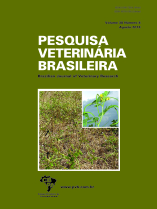 |
|
|
|
Year 2018 - Volume 38, Number 8
|

|
Gastrointestinal parasites in goats from Quixadá, Ceará, 38(8):1505-1510
|
ABSTRACT.- Oliveira D.A.S., Brito R.L.L., Neves M.R.M., Sousa M.M., Miranda R.R.C., Mourão A.E.B., Cavalcante A.C.R. & Vieira L.S. 2018. [Gastrointestinal parasites in goats from Quixadá, Ceará.] Parasitos gastrintestinais em caprinos no município de Quixadá, Ceará. Pesquisa Veterinária Brasileira 38(8):1505-1510. Programa de Pós-Graduação em Zootecnia, Centro de Ciências Agrárias e Biológicas, Universidade Estadual do Vale do Acaraú, Avenida da Universidade 850, Campus Betânia, Sobral, CE 62040-370, Brazil. E-mail: dalilian.an@gmail.com
The objective of this study was to evaluate the occurrence of main gastrointestinal parasites and to quantify and identify the species of Eimeria present in young goats and adults in the city of Quixadá, Ceará, during the dry and rainy season. Six hundred fifty-four animals were used, with 334 animals during the dry season, which were 149 mothers and 185 offspring and 320 animals during the rainy season, with 106 mothers and 214 offspring, independent of breed standard and creation system. Samples were collected in the months of November and December 2012 and May 2013 in the city of Quixadá, Ceará and sent to the Parasitology Laboratory of Embrapa Goats and Sheep at Sobral, Ceará, feces were collected for counting the number of eggs per gram of feces (EPG), counting oocysts per gram of feces (OOPG), coproculture and identification of Eimeria species based on the morphometry. Matrices showed higher means egg type Strongyloidea (372.03) and Strongyloides (8.45) in the dry season and the rainy season had higher mean only to Strongyloidea (502.85). The inverse happened to OOPG, where the offspring showed higher means in the dry season (9387.41) and rainy (9630.37). The genus most frequent of nematode in coprocultures was Trichostrongylus. (63.67%) in the dry season and Haemonchus sp. the rainy (66.67%). One hundred percent of the herds, oocysts of Eimeria were found, with 81% of infected animals. The occurrence of eimeriosis in young and adult categories was 64.3% and 83.2% in the dry season and 87.4% and 92.4% during the rainy season. The species identified were: Eimeria alijevi, E. apsheronica, E. arloingi, E. caprina, E. caprovina, E. christenseni, E. hirci, E. and E. jolchijevi ninakohlyakimovae. In the offspring E. alijevi was the most frequent in the dry season and the rainy E. ninakohlyakimovae. Already in matrices the species E. Alijevi showed the highest frequency in both periods. In herds studied it evidenced the presence of gastrointestinal nematodes eggs and oocysts of Eimeria spp. independent of animal category. |
| |
|
|
| |
|
 |